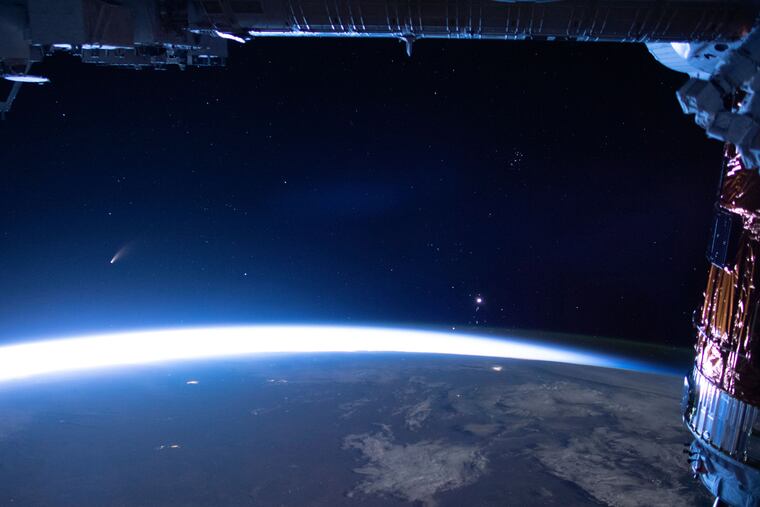Things are looking up, at least for skywatchers, with rare comet, and space-station sightings
The International Space Station will be visible for several nights, a few hours after Comet NEOWISE appears. Space-walking astronauts on live TV Thursday and Tuesday.

Skywatchers will have excellent opportunities for the next several nights to see the Comet NEOWISE — making what is believed to be its first earthly visit in about 7,000 years — and the International Space Station.
The space station makes its next appearance over Philadelphia at 10:03 p.m. Thursday, zipping along at a brisk 17,500 mph from west to northeast, followed by a cameo appearance at 11:44 that will last under a minute.
It also will be visible for the next several nights. Clouds permitting, it can be seen clearly without binoculars or telescopes, and might look like an ultra-speeding jet or one quite-brilliant star.
» READ MORE: NASA to allow private citizens to fly to the International Space Station
Meanwhile, NASA astronauts Chris Cassidy and Robert Behnken were scheduled to do some battery-replacement work outside the station on Thursday and Tuesday.
While their handiwork won’t be visible from the ground, NASA is providing live TV coverage on its website. This is a little more complicated than replacing flashlight batteries, so it could take up to seven hours.
The station, which has been up there for two decades, is host to a variety of experiments. It is also being used to analyze the impacts of longer-term spaceflight on the human body, and after weeks of isolation, many us might envy all that weightlessness.
A few hours before the space station sightings, comet NEOWISE will be the star attraction, although don’t expect a flash of brilliance, even though it’s moving about 144,000 mph, or nine times faster than the space station.
» READ MORE: Comet's impact seen in New Jersey, possibly tied to prehistoric global warming
It has been appearing in a large part of the northern hemisphere around daybreak, and this week that ice-ball from outer space has become visible — with binoculars, anyway — at dusk.
NASA says it will be showing up progressively higher in the sky in the coming days; look toward the northwest.
“We still have to wait for another very bright comet, what astronomers call a great comet,” says EarthSky.org, but it describes NEOWISE, as “a wonderful binocular comet.”
It’s at least possible that NEOWISE will end the wait and blossom into a great comet, Emily Kramer, with NASA’s Jet Propulsion Laboratory, said at a briefing Wednesday afternoon, but “comets are notoriously hard to predict.”
The comet takes its name from the space-observation system that discovered it.
If you miss it this time around, not to worry. If all goes well, it should return about 8900, give or take a few years.
But NASA’s Joe Masiero cautioned that they do tend to lose some brightness over the years.